FORD F150 2013 12.G Owners Manual
Manufacturer: FORD, Model Year: 2013, Model line: F150, Model: FORD F150 2013 12.GPages: 570, PDF Size: 6.13 MB
Page 211 of 570
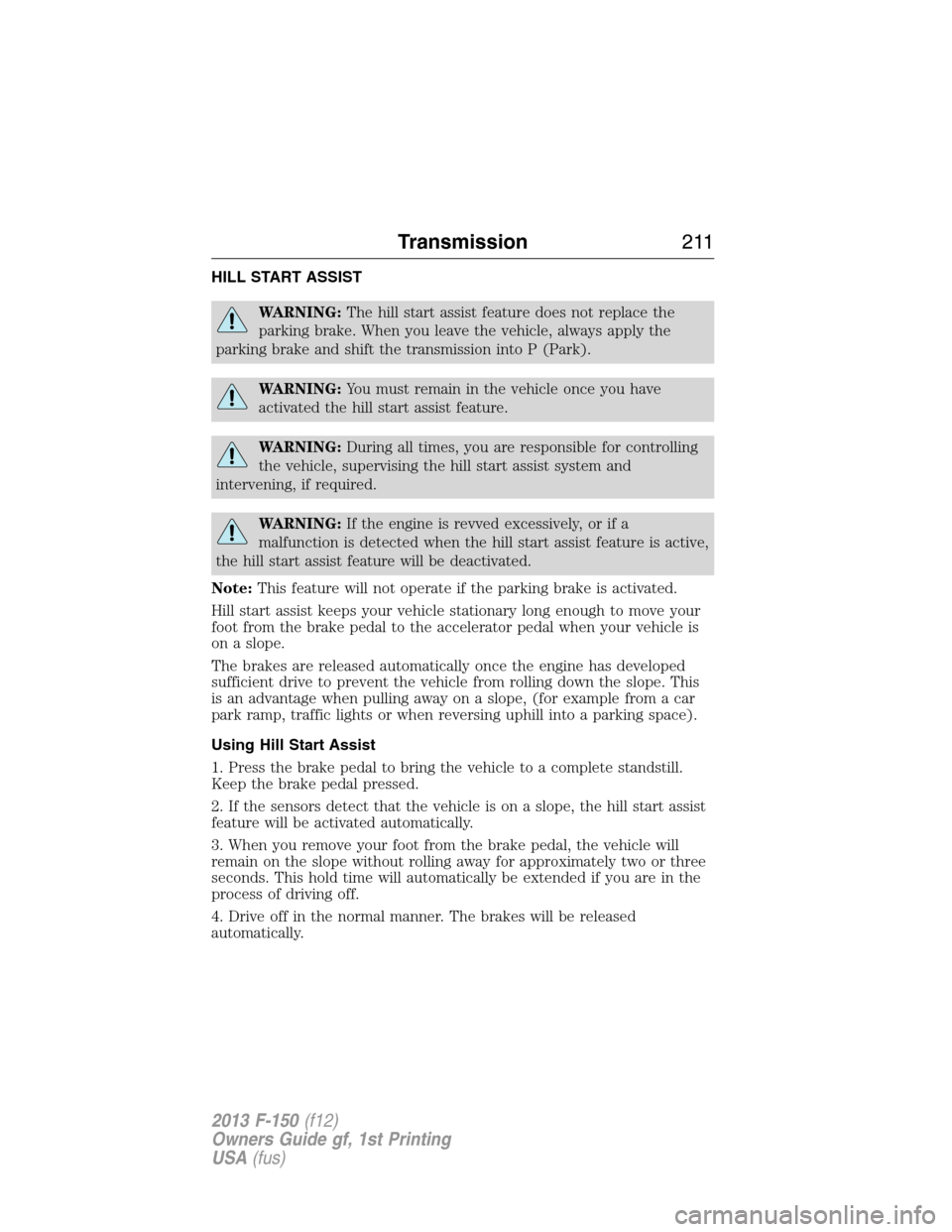
HILL START ASSIST
WARNING:The hill start assist feature does not replace the
parking brake. When you leave the vehicle, always apply the
parking brake and shift the transmission into P (Park).
WARNING:You must remain in the vehicle once you have
activated the hill start assist feature.
WARNING:During all times, you are responsible for controlling
the vehicle, supervising the hill start assist system and
intervening, if required.
WARNING:If the engine is revved excessively, or if a
malfunction is detected when the hill start assist feature is active,
the hill start assist feature will be deactivated.
Note:This feature will not operate if the parking brake is activated.
Hill start assist keeps your vehicle stationary long enough to move your
foot from the brake pedal to the accelerator pedal when your vehicle is
on a slope.
The brakes are released automatically once the engine has developed
sufficient drive to prevent the vehicle from rolling down the slope. This
is an advantage when pulling away on a slope, (for example from a car
park ramp, traffic lights or when reversing uphill into a parking space).
Using Hill Start Assist
1. Press the brake pedal to bring the vehicle to a complete standstill.
Keep the brake pedal pressed.
2. If the sensors detect that the vehicle is on a slope, the hill start assist
feature will be activated automatically.
3. When you remove your foot from the brake pedal, the vehicle will
remain on the slope without rolling away for approximately two or three
seconds. This hold time will automatically be extended if you are in the
process of driving off.
4. Drive off in the normal manner. The brakes will be released
automatically.
Transmission211
2013 F-150(f12)
Owners Guide gf, 1st Printing
USA(fus)
Page 212 of 570
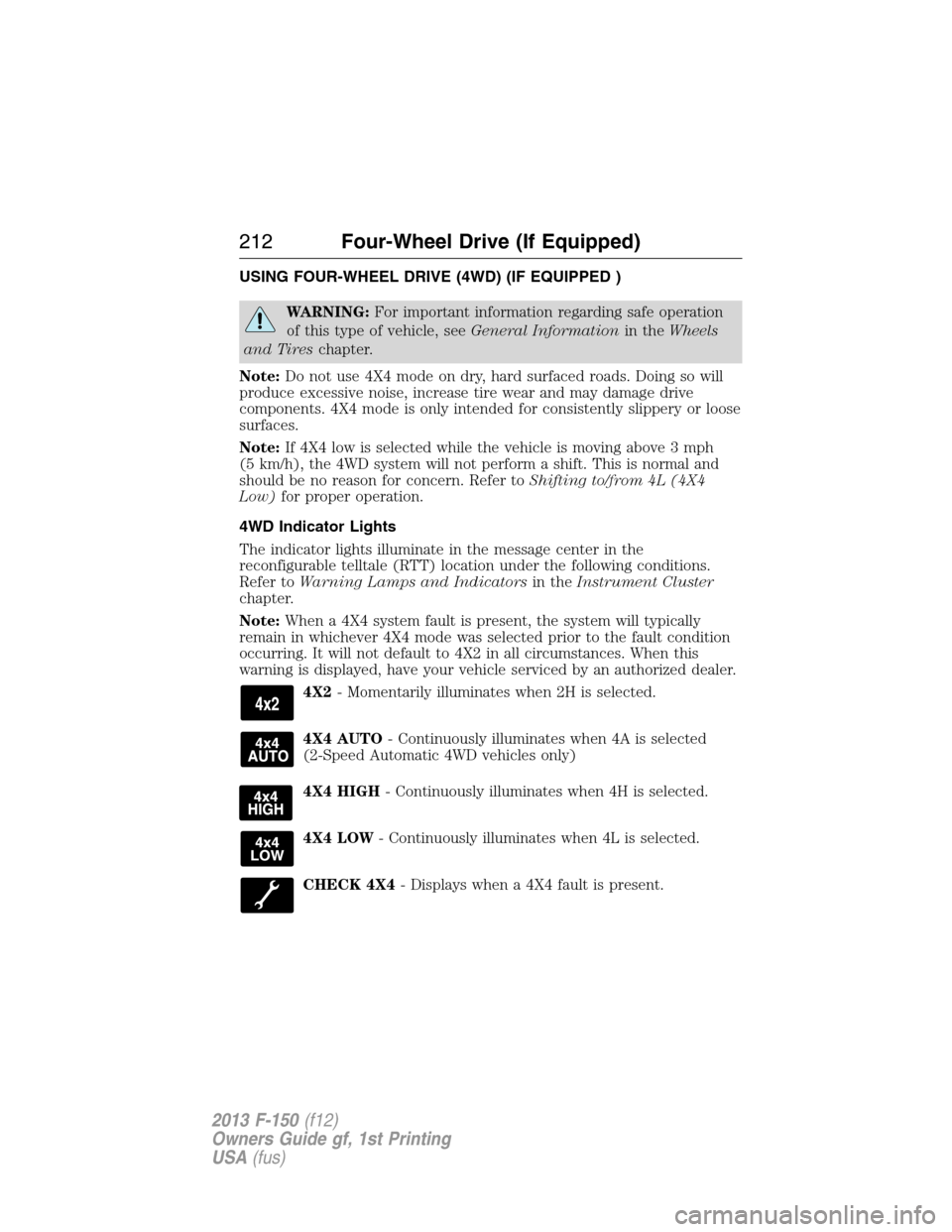
USING FOUR-WHEEL DRIVE (4WD) (IF EQUIPPED )
WARNING:For important information regarding safe operation
of this type of vehicle, seeGeneral Informationin theWheels
and Tireschapter.
Note:Do not use 4X4 mode on dry, hard surfaced roads. Doing so will
produce excessive noise, increase tire wear and may damage drive
components. 4X4 mode is only intended for consistently slippery or loose
surfaces.
Note:If 4X4 low is selected while the vehicle is moving above 3 mph
(5 km/h), the 4WD system will not perform a shift. This is normal and
should be no reason for concern. Refer toShifting to/from 4L (4X4
Low)for proper operation.
4WD Indicator Lights
The indicator lights illuminate in the message center in the
reconfigurable telltale (RTT) location under the following conditions.
Refer toWarning Lamps and Indicatorsin theInstrument Cluster
chapter.
Note:When a 4X4 system fault is present, the system will typically
remain in whichever 4X4 mode was selected prior to the fault condition
occurring. It will not default to 4X2 in all circumstances. When this
warning is displayed, have your vehicle serviced by an authorized dealer.
4X2- Momentarily illuminates when 2H is selected.
4X4 AUTO- Continuously illuminates when 4A is selected
(2-Speed Automatic 4WD vehicles only)
4X4 HIGH- Continuously illuminates when 4H is selected.
4X4 LOW- Continuously illuminates when 4L is selected.
CHECK 4X4- Displays when a 4X4 fault is present.
212Four-Wheel Drive (If Equipped)
2013 F-150(f12)
Owners Guide gf, 1st Printing
USA(fus)
Page 213 of 570
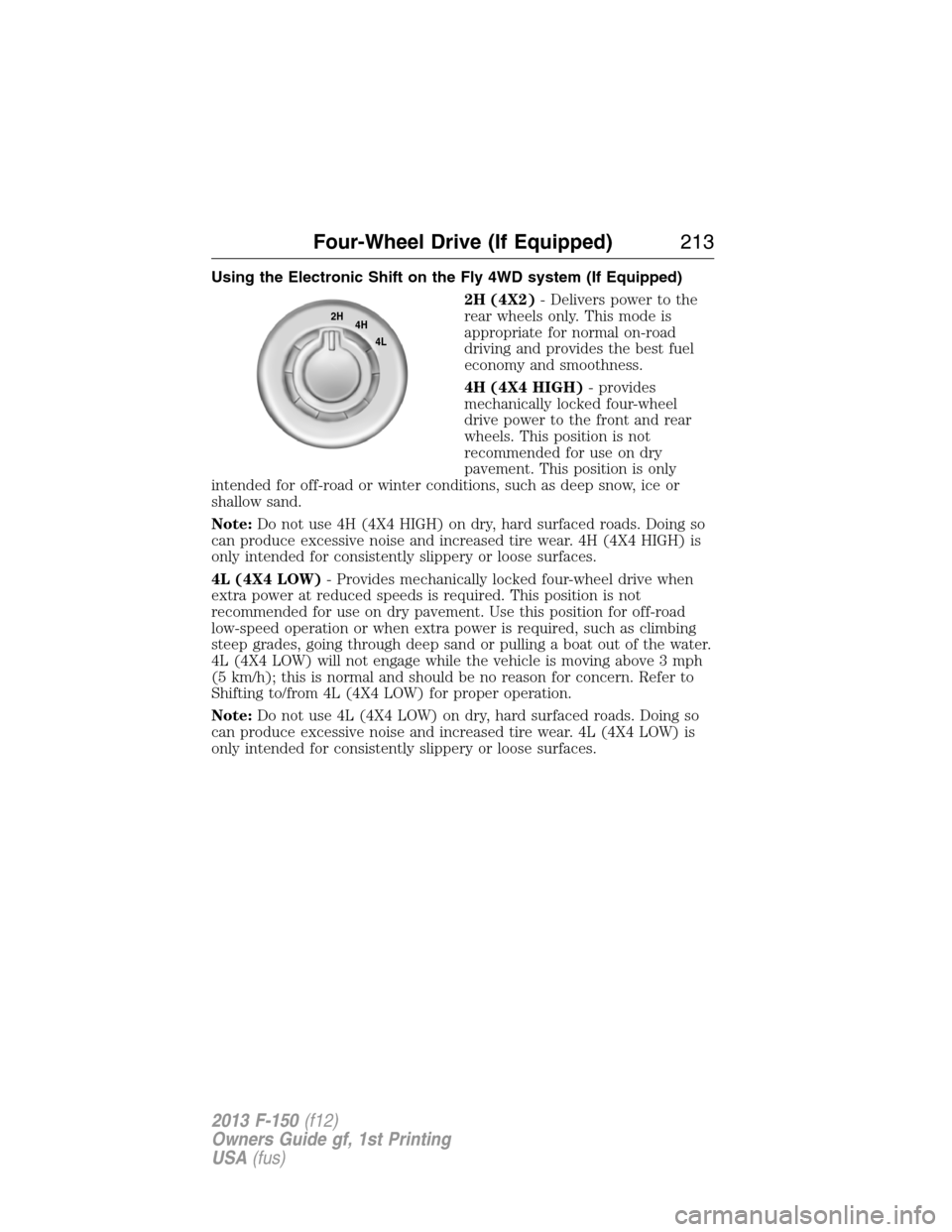
Using the Electronic Shift on the Fly 4WD system (If Equipped)
2H (4X2)- Delivers power to the
rear wheels only. This mode is
appropriate for normal on-road
driving and provides the best fuel
economy and smoothness.
4H (4X4 HIGH)- provides
mechanically locked four-wheel
drive power to the front and rear
wheels. This position is not
recommended for use on dry
pavement. This position is only
intended for off-road or winter conditions, such as deep snow, ice or
shallow sand.
Note:Do not use 4H (4X4 HIGH) on dry, hard surfaced roads. Doing so
can produce excessive noise and increased tire wear. 4H (4X4 HIGH) is
only intended for consistently slippery or loose surfaces.
4L (4X4 LOW)- Provides mechanically locked four-wheel drive when
extra power at reduced speeds is required. This position is not
recommended for use on dry pavement. Use this position for off-road
low-speed operation or when extra power is required, such as climbing
steep grades, going through deep sand or pulling a boat out of the water.
4L (4X4 LOW) will not engage while the vehicle is moving above 3 mph
(5 km/h); this is normal and should be no reason for concern. Refer to
Shifting to/from 4L (4X4 LOW) for proper operation.
Note:Do not use 4L (4X4 LOW) on dry, hard surfaced roads. Doing so
can produce excessive noise and increased tire wear. 4L (4X4 LOW) is
only intended for consistently slippery or loose surfaces.
2H
4H
4L
Four-Wheel Drive (If Equipped)213
2013 F-150(f12)
Owners Guide gf, 1st Printing
USA(fus)
Page 214 of 570

Shifting between 2H (4X2) and 4H (4X4 High)
Move the 4WD control between 2H (4X2) and 4H (4X4 HIGH) at any
forward speed. The message center will display4X4 SHIFT IN
PROGRESSduring the system shift.4X4 HIGHwill display in the
message center if 4H is selected and4X2will momentarily display in the
message center if 2H is selected.
IfSHIFT DELAYED PULL FORWARDis displayed in the message
center during the mode shift, transfer case gear tooth blockage is
present. To alleviate this condition, place the transmission in a forward
gear and move the vehicle forward approximately 5 feet (2 meters) to
allow the transfer case to complete the mode shift.
Note:Momentarily releasing the accelerator pedal while performing a
shift will improve engagement/disengagement times.
Note:Do not perform this operation if the rear wheels are slipping.
Note:Some noise may be heard as the system shifts or engages; this is
normal.
Note:4X4 high mode is not intended for use on dry pavement.
Shifting to/from 4L (4X4 low)
1. Bring the vehicle to a speed of 3 mph (5 km/h) or less.
2. Place the transmission in N (Neutral).
3. Move the 4WD control to the desired position.
The message center will display4X4 SHIFT IN PROGRESSduring the
shift. The message center will then display the system mode selected. If
any of the above shift conditions are not met, the shift will not occur and
the message center will display information guiding the driver through
the proper shifting procedures.
IfSHIFT DELAYED PULL FORWARDis displayed in the message
center, transfer case gear tooth blockage is present. To alleviate this
condition, place the transmission in a forward gear, move the vehicle
forward approximately 5 feet (1.5 m), and shift the transmission back to
neutral to allow the transfer case to complete the range shift.
Note:Some noise may be heard as the system shifts or engages; this is
normal.
Note:4x4 low mode is not intended for use on dry pavement.
214Four-Wheel Drive (If Equipped)
2013 F-150(f12)
Owners Guide gf, 1st Printing
USA(fus)
Page 215 of 570
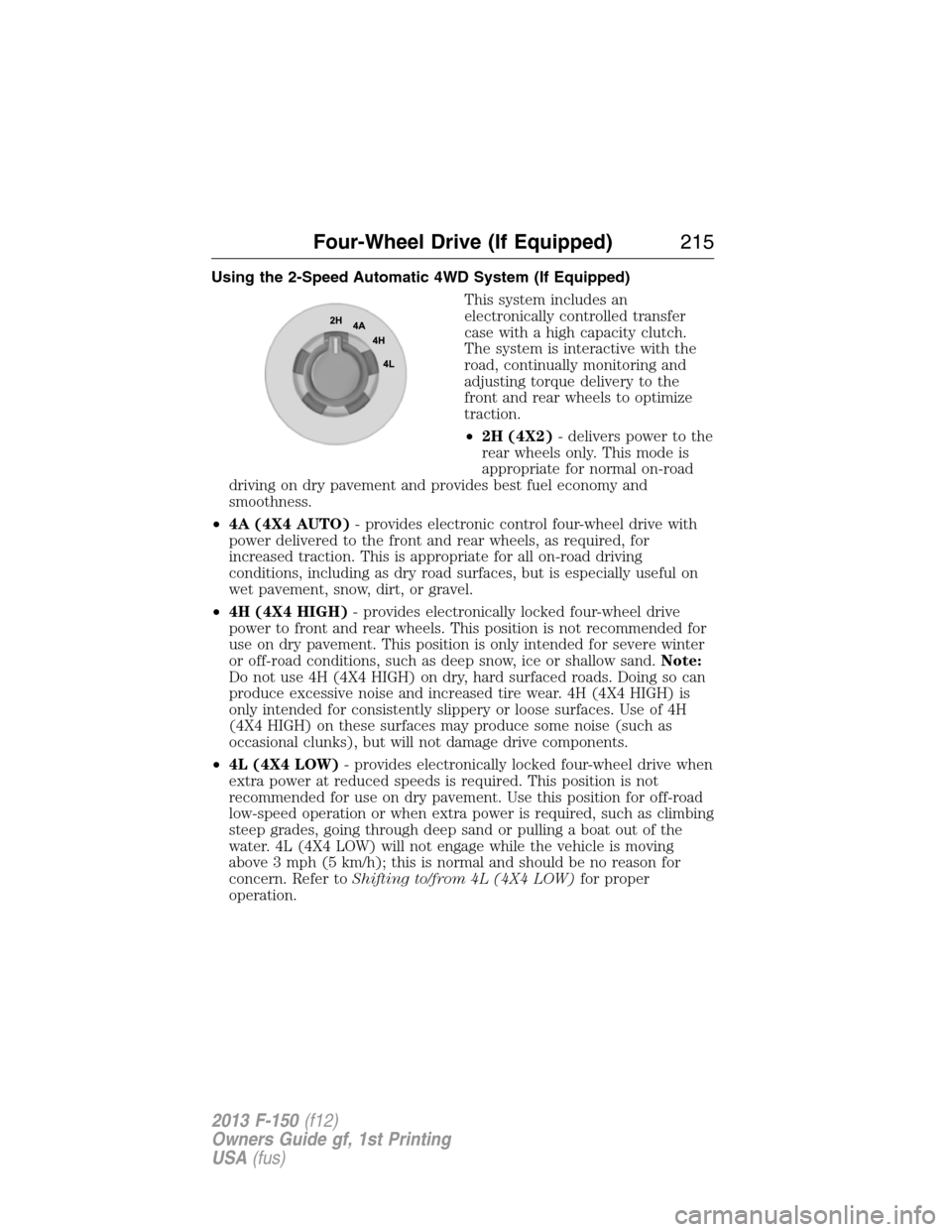
Using the 2-Speed Automatic 4WD System (If Equipped)
This system includes an
electronically controlled transfer
case with a high capacity clutch.
The system is interactive with the
road, continually monitoring and
adjusting torque delivery to the
front and rear wheels to optimize
traction.
•2H (4X2)- delivers power to the
rear wheels only. This mode is
appropriate for normal on-road
driving on dry pavement and provides best fuel economy and
smoothness.
•4A (4X4 AUTO)- provides electronic control four-wheel drive with
power delivered to the front and rear wheels, as required, for
increased traction. This is appropriate for all on-road driving
conditions, including as dry road surfaces, but is especially useful on
wet pavement, snow, dirt, or gravel.
•4H (4X4 HIGH)- provides electronically locked four-wheel drive
power to front and rear wheels. This position is not recommended for
use on dry pavement. This position is only intended for severe winter
or off-road conditions, such as deep snow, ice or shallow sand.Note:
Do not use 4H (4X4 HIGH) on dry, hard surfaced roads. Doing so can
produce excessive noise and increased tire wear. 4H (4X4 HIGH) is
only intended for consistently slippery or loose surfaces. Use of 4H
(4X4 HIGH) on these surfaces may produce some noise (such as
occasional clunks), but will not damage drive components.
•4L (4X4 LOW)- provides electronically locked four-wheel drive when
extra power at reduced speeds is required. This position is not
recommended for use on dry pavement. Use this position for off-road
low-speed operation or when extra power is required, such as climbing
steep grades, going through deep sand or pulling a boat out of the
water. 4L (4X4 LOW) will not engage while the vehicle is moving
above 3 mph (5 km/h); this is normal and should be no reason for
concern. Refer toShifting to/from 4L (4X4 LOW)for proper
operation.
Four-Wheel Drive (If Equipped)215
2013 F-150(f12)
Owners Guide gf, 1st Printing
USA(fus)
Page 216 of 570
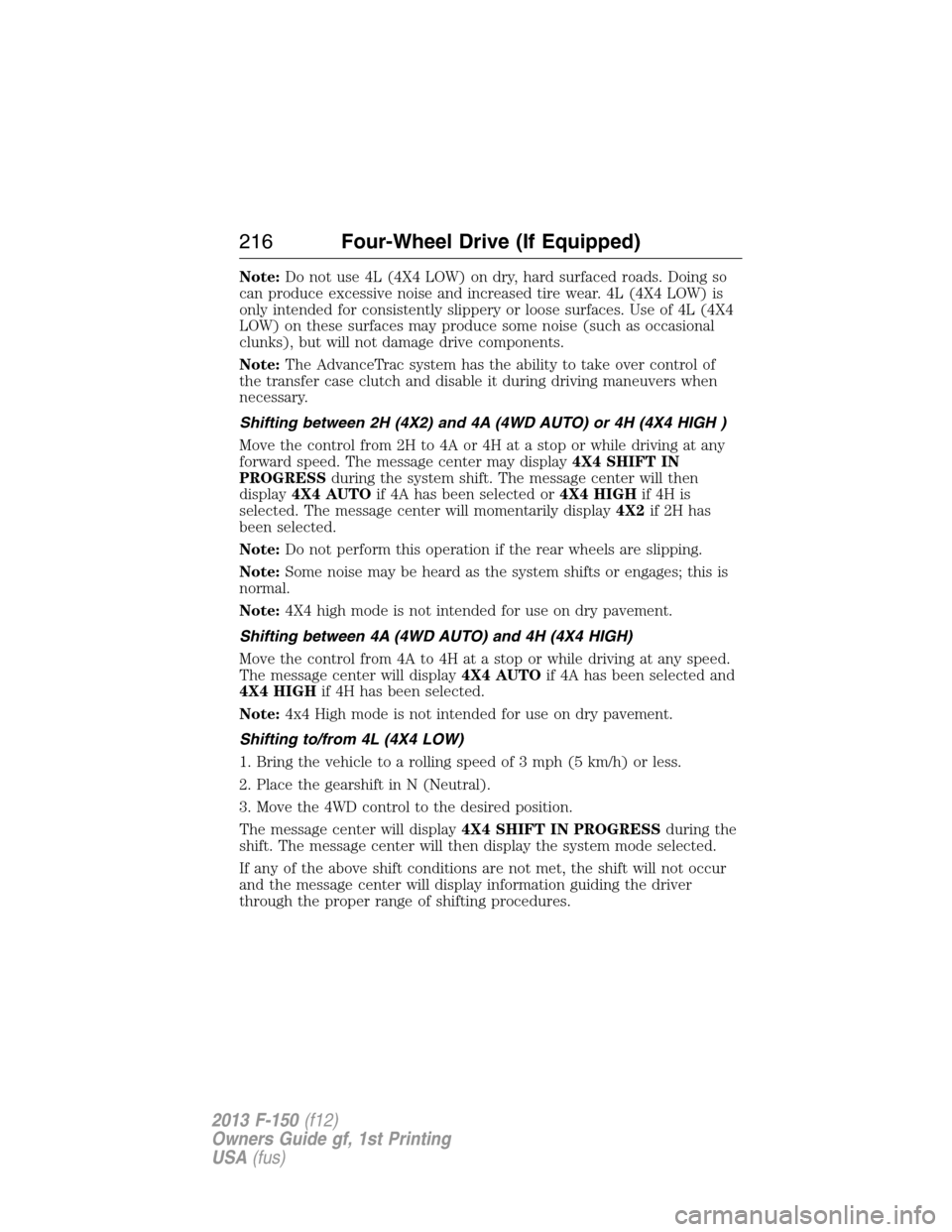
Note:Do not use 4L (4X4 LOW) on dry, hard surfaced roads. Doing so
can produce excessive noise and increased tire wear. 4L (4X4 LOW) is
only intended for consistently slippery or loose surfaces. Use of 4L (4X4
LOW) on these surfaces may produce some noise (such as occasional
clunks), but will not damage drive components.
Note:The AdvanceTrac system has the ability to take over control of
the transfer case clutch and disable it during driving maneuvers when
necessary.
Shifting between 2H (4X2) and 4A (4WD AUTO) or 4H (4X4 HIGH )
Move the control from 2H to 4A or 4H at a stop or while driving at any
forward speed. The message center may display4X4 SHIFT IN
PROGRESSduring the system shift. The message center will then
display4X4 AUTOif 4A has been selected or4X4 HIGHif 4H is
selected. The message center will momentarily display4X2if 2H has
been selected.
Note:Do not perform this operation if the rear wheels are slipping.
Note:Some noise may be heard as the system shifts or engages; this is
normal.
Note:4X4 high mode is not intended for use on dry pavement.
Shifting between 4A (4WD AUTO) and 4H (4X4 HIGH)
Move the control from 4A to 4H at a stop or while driving at any speed.
The message center will display4X4 AUTOif 4A has been selected and
4X4 HIGHif 4H has been selected.
Note:4x4 High mode is not intended for use on dry pavement.
Shifting to/from 4L (4X4 LOW)
1. Bring the vehicle to a rolling speed of 3 mph (5 km/h) or less.
2. Place the gearshift in N (Neutral).
3. Move the 4WD control to the desired position.
The message center will display4X4 SHIFT IN PROGRESSduring the
shift. The message center will then display the system mode selected.
If any of the above shift conditions are not met, the shift will not occur
and the message center will display information guiding the driver
through the proper range of shifting procedures.
216Four-Wheel Drive (If Equipped)
2013 F-150(f12)
Owners Guide gf, 1st Printing
USA(fus)
Page 217 of 570
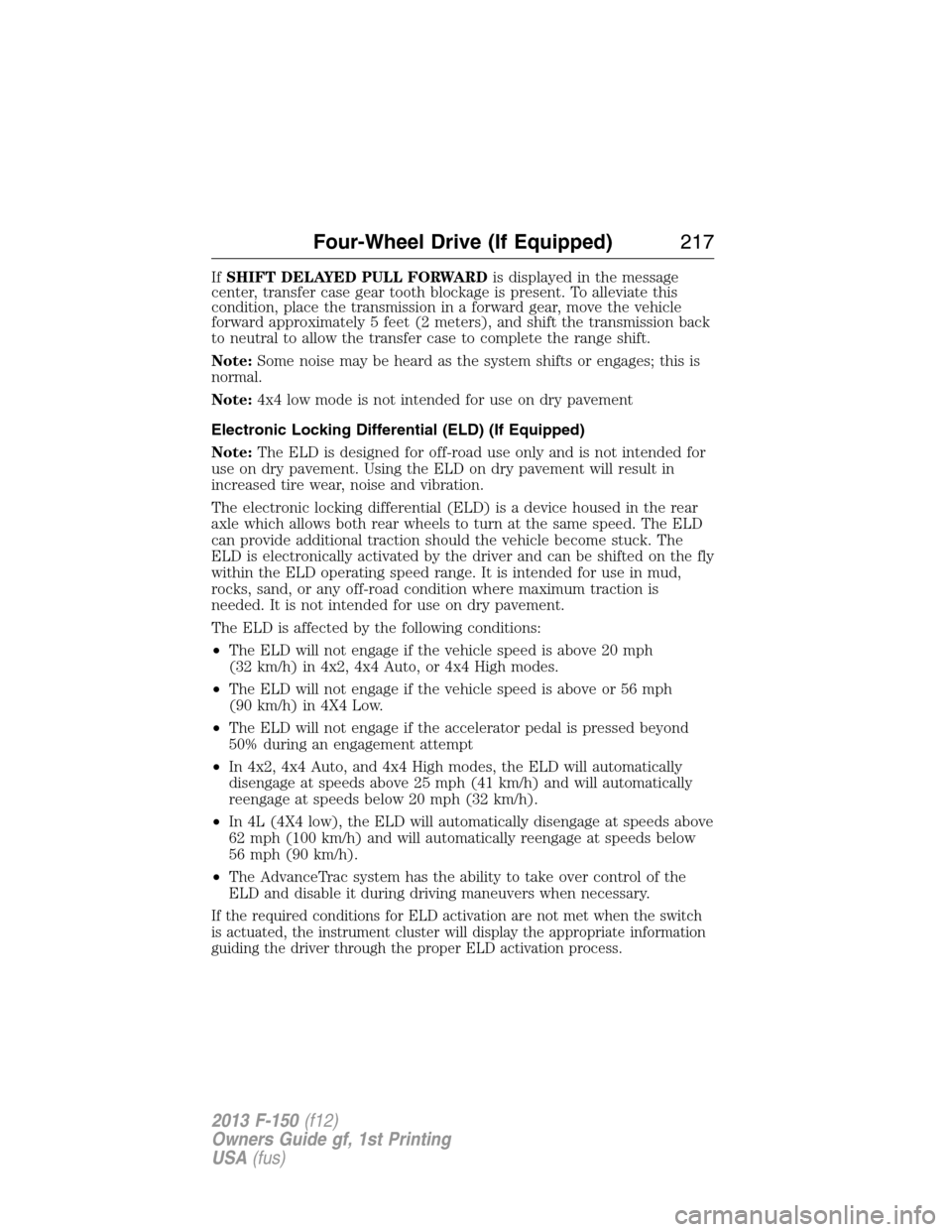
IfSHIFT DELAYED PULL FORWARDis displayed in the message
center, transfer case gear tooth blockage is present. To alleviate this
condition, place the transmission in a forward gear, move the vehicle
forward approximately 5 feet (2 meters), and shift the transmission back
to neutral to allow the transfer case to complete the range shift.
Note:Some noise may be heard as the system shifts or engages; this is
normal.
Note:4x4 low mode is not intended for use on dry pavement
Electronic Locking Differential (ELD) (If Equipped)
Note:The ELD is designed for off-road use only and is not intended for
use on dry pavement. Using the ELD on dry pavement will result in
increased tire wear, noise and vibration.
The electronic locking differential (ELD) is a device housed in the rear
axle which allows both rear wheels to turn at the same speed. The ELD
can provide additional traction should the vehicle become stuck. The
ELD is electronically activated by the driver and can be shifted on the fly
within the ELD operating speed range. It is intended for use in mud,
rocks, sand, or any off-road condition where maximum traction is
needed. It is not intended for use on dry pavement.
The ELD is affected by the following conditions:
•The ELD will not engage if the vehicle speed is above 20 mph
(32 km/h) in 4x2, 4x4 Auto, or 4x4 High modes.
•The ELD will not engage if the vehicle speed is above or 56 mph
(90 km/h) in 4X4 Low.
•The ELD will not engage if the accelerator pedal is pressed beyond
50% during an engagement attempt
•In 4x2, 4x4 Auto, and 4x4 High modes, the ELD will automatically
disengage at speeds above 25 mph (41 km/h) and will automatically
reengage at speeds below 20 mph (32 km/h).
•In 4L (4X4 low), the ELD will automatically disengage at speeds above
62 mph (100 km/h) and will automatically reengage at speeds below
56 mph (90 km/h).
•The AdvanceTrac system has the ability to take over control of the
ELD and disable it during driving maneuvers when necessary.
If the required conditions for ELD activation are not met when the switch
is actuated, the instrument cluster will display the appropriate information
guiding the driver through the proper ELD activation process.
Four-Wheel Drive (If Equipped)217
2013 F-150(f12)
Owners Guide gf, 1st Printing
USA(fus)
Page 218 of 570
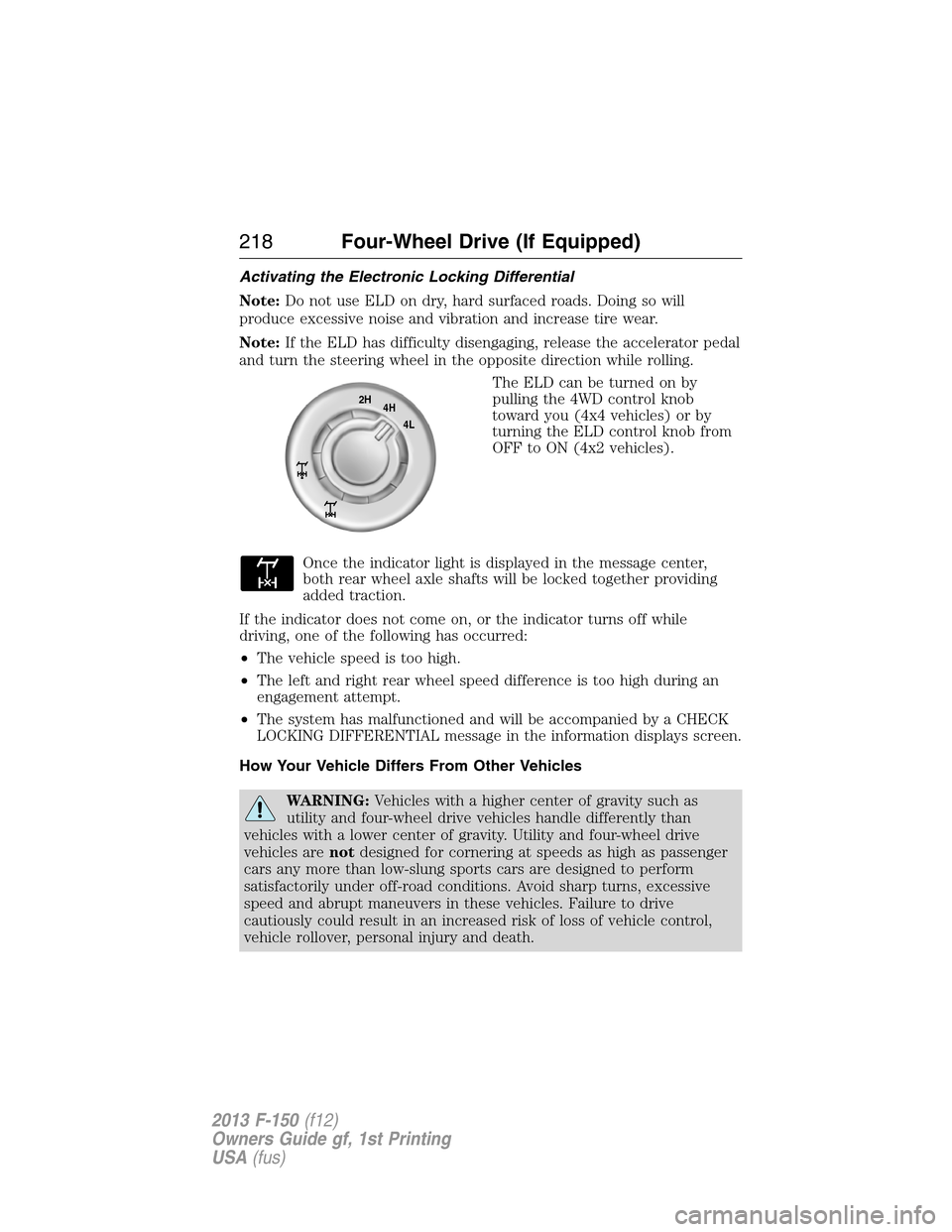
Activating the Electronic Locking Differential
Note:Do not use ELD on dry, hard surfaced roads. Doing so will
produce excessive noise and vibration and increase tire wear.
Note:If the ELD has difficulty disengaging, release the accelerator pedal
and turn the steering wheel in the opposite direction while rolling.
The ELD can be turned on by
pulling the 4WD control knob
toward you (4x4 vehicles) or by
turning the ELD control knob from
OFF to ON (4x2 vehicles).
Once the indicator light is displayed in the message center,
both rear wheel axle shafts will be locked together providing
added traction.
If the indicator does not come on, or the indicator turns off while
driving, one of the following has occurred:
•The vehicle speed is too high.
•The left and right rear wheel speed difference is too high during an
engagement attempt.
•The system has malfunctioned and will be accompanied by a CHECK
LOCKING DIFFERENTIAL message in the information displays screen.
How Your Vehicle Differs From Other Vehicles
WARNING:Vehicles with a higher center of gravity such as
utility and four-wheel drive vehicles handle differently than
vehicles with a lower center of gravity. Utility and four-wheel drive
vehicles arenotdesigned for cornering at speeds as high as passenger
cars any more than low-slung sports cars are designed to perform
satisfactorily under off-road conditions. Avoid sharp turns, excessive
speed and abrupt maneuvers in these vehicles. Failure to drive
cautiously could result in an increased risk of loss of vehicle control,
vehicle rollover, personal injury and death.
2H
4H
4L
218Four-Wheel Drive (If Equipped)
2013 F-150(f12)
Owners Guide gf, 1st Printing
USA(fus)
Page 219 of 570
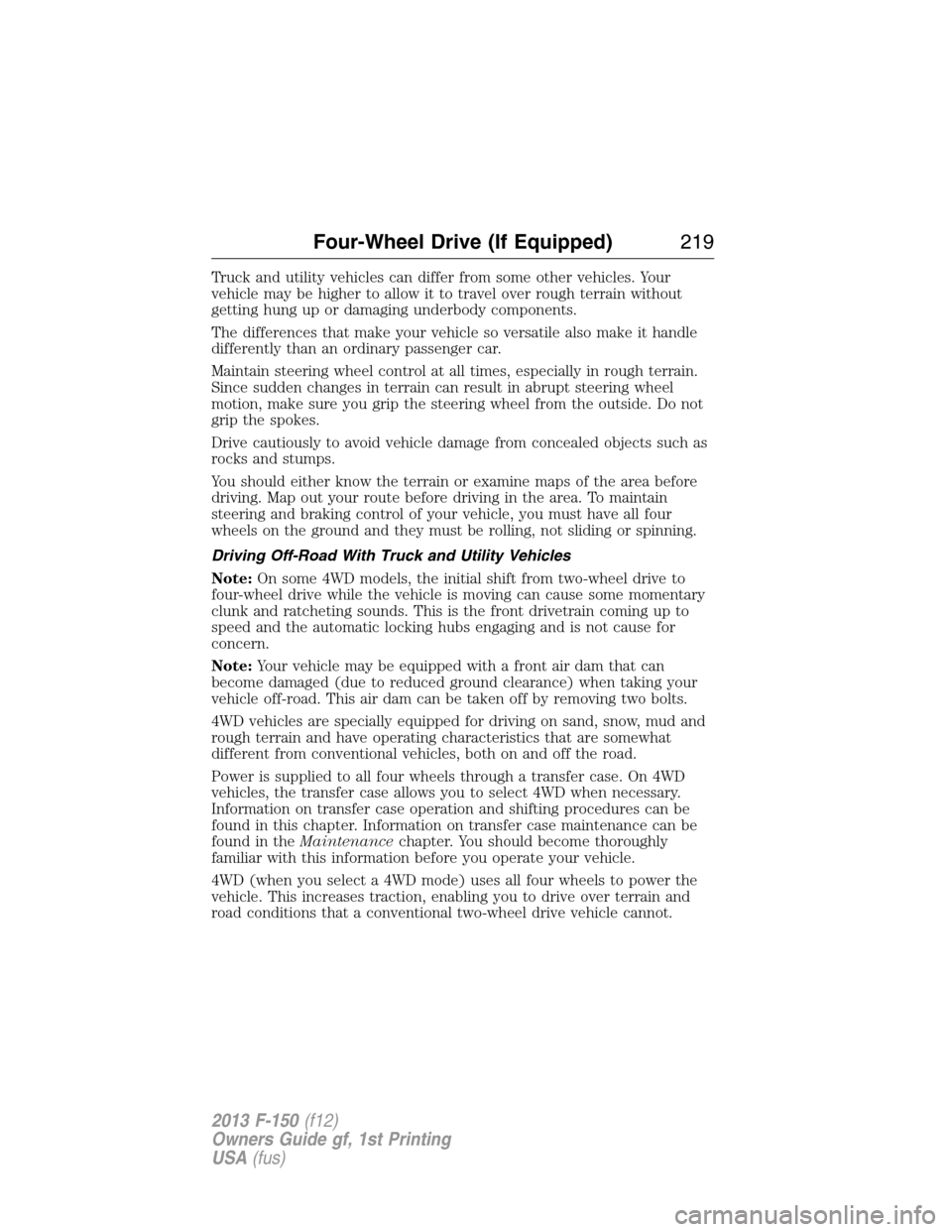
Truck and utility vehicles can differ from some other vehicles. Your
vehicle may be higher to allow it to travel over rough terrain without
getting hung up or damaging underbody components.
The differences that make your vehicle so versatile also make it handle
differently than an ordinary passenger car.
Maintain steering wheel control at all times, especially in rough terrain.
Since sudden changes in terrain can result in abrupt steering wheel
motion, make sure you grip the steering wheel from the outside. Do not
grip the spokes.
Drive cautiously to avoid vehicle damage from concealed objects such as
rocks and stumps.
You should either know the terrain or examine maps of the area before
driving. Map out your route before driving in the area. To maintain
steering and braking control of your vehicle, you must have all four
wheels on the ground and they must be rolling, not sliding or spinning.
Driving Off-Road With Truck and Utility Vehicles
Note:On some 4WD models, the initial shift from two-wheel drive to
four-wheel drive while the vehicle is moving can cause some momentary
clunk and ratcheting sounds. This is the front drivetrain coming up to
speed and the automatic locking hubs engaging and is not cause for
concern.
Note:Your vehicle may be equipped with a front air dam that can
become damaged (due to reduced ground clearance) when taking your
vehicle off-road. This air dam can be taken off by removing two bolts.
4WD vehicles are specially equipped for driving on sand, snow, mud and
rough terrain and have operating characteristics that are somewhat
different from conventional vehicles, both on and off the road.
Power is supplied to all four wheels through a transfer case. On 4WD
vehicles, the transfer case allows you to select 4WD when necessary.
Information on transfer case operation and shifting procedures can be
found in this chapter. Information on transfer case maintenance can be
found in theMaintenancechapter. You should become thoroughly
familiar with this information before you operate your vehicle.
4WD (when you select a 4WD mode) uses all four wheels to power the
vehicle. This increases traction, enabling you to drive over terrain and
road conditions that a conventional two-wheel drive vehicle cannot.
Four-Wheel Drive (If Equipped)219
2013 F-150(f12)
Owners Guide gf, 1st Printing
USA(fus)
Page 220 of 570
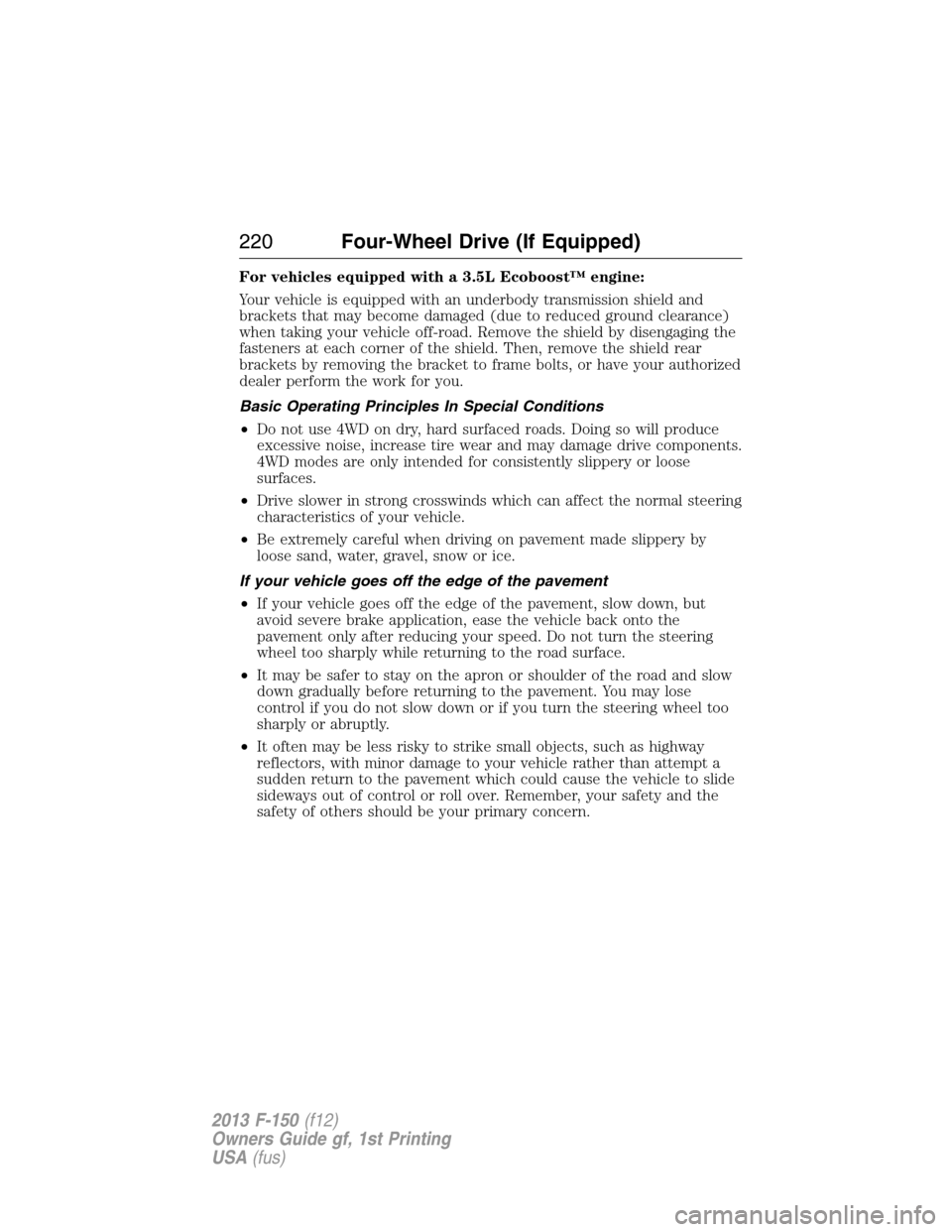
For vehicles equipped with a 3.5L Ecoboost™ engine:
Your vehicle is equipped with an underbody transmission shield and
brackets that may become damaged (due to reduced ground clearance)
when taking your vehicle off-road. Remove the shield by disengaging the
fasteners at each corner of the shield. Then, remove the shield rear
brackets by removing the bracket to frame bolts, or have your authorized
dealer perform the work for you.
Basic Operating Principles In Special Conditions
•Do not use 4WD on dry, hard surfaced roads. Doing so will produce
excessive noise, increase tire wear and may damage drive components.
4WD modes are only intended for consistently slippery or loose
surfaces.
•Drive slower in strong crosswinds which can affect the normal steering
characteristics of your vehicle.
•Be extremely careful when driving on pavement made slippery by
loose sand, water, gravel, snow or ice.
If your vehicle goes off the edge of the pavement
•If your vehicle goes off the edge of the pavement, slow down, but
avoid severe brake application, ease the vehicle back onto the
pavement only after reducing your speed. Do not turn the steering
wheel too sharply while returning to the road surface.
•It may be safer to stay on the apron or shoulder of the road and slow
down gradually before returning to the pavement. You may lose
control if you do not slow down or if you turn the steering wheel too
sharply or abruptly.
•It often may be less risky to strike small objects, such as highway
reflectors, with minor damage to your vehicle rather than attempt a
sudden return to the pavement which could cause the vehicle to slide
sideways out of control or roll over. Remember, your safety and the
safety of others should be your primary concern.
220Four-Wheel Drive (If Equipped)
2013 F-150(f12)
Owners Guide gf, 1st Printing
USA(fus)